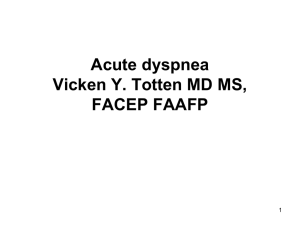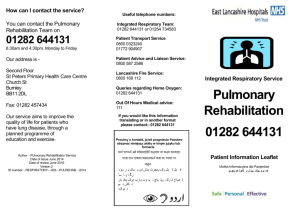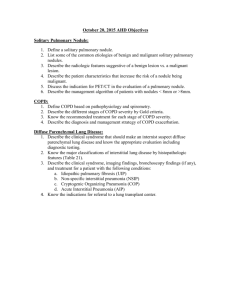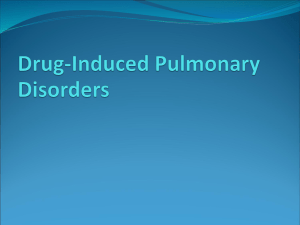DEFINITION
advertisement
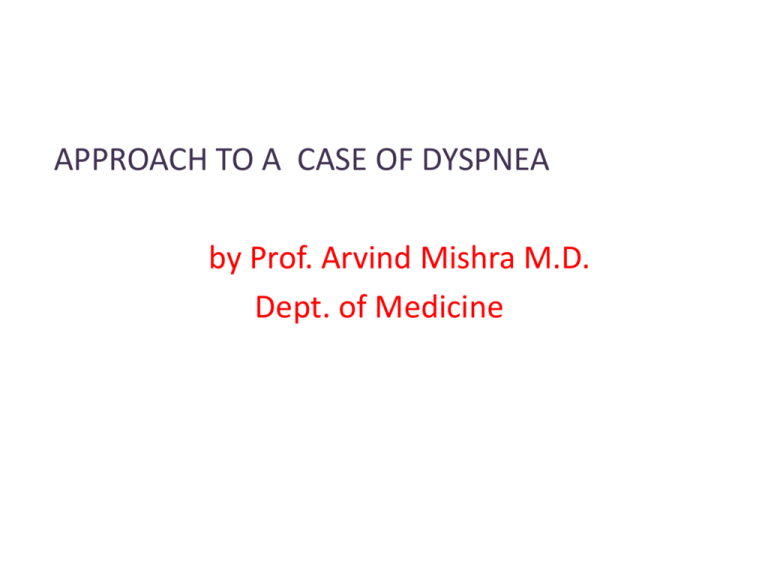
APPROACH TO A CASE OF DYSPNEA by Prof. Arvind Mishra M.D. Dept. of Medicine DEFINITION A subjective experience of breathing discomfort that consists of qualitatively distinct sensations that vary in intensity (By American Thoracic Society) CAUSES OF DYSPNEA 1)Respiratory causes 2)Cardiovascular causes 3)Dyspnea with normal cardiorespiratory function RESPIRATORY CAUSES 1. Diseases of the airway 2. Diseases of the pleura and lung parenchyma 3. Diseases of the chest wall 1)Diseases of the airway e.g. Asthma and COPD Characterised by expiratory airflow obstruction Hyperinflation of lung and chest wall Increased resistive and elastic load on the ventilatory muscles and increased work of breathing Hypoxia 2)Diseases of the pleura and lung parenchyma • Pleural effusion • Infective diseases of parenchyma - Pneumonia -Pneumonia occuring over existing parenchymal infective diseases-Bronchiectasis,lung abscess • Interstitial lung disease – caused by -occupational exposures - autoimmune disorders 3)Diseases of the chest wall a)Diseases that stiffens the chest wall -kyphoscoliosis b)Diseases that weakens the chest wall -myasthenia gravis and guillain - barre syndrome CARDIOVASCULAR CAUSES • Diseases of left heart • Diseases of pulmonary vasculature • Diseases of pericardium Diseases of left heart e.g. Coronary heart diseases Valvular heart diseases Dilated cardiomyopathy Greater end diastolic volume and incresed LV end diastolic and pulmonary capillary pressure Interstitial edema and stimulation of pulmonary receptors leading to dyspnea Diseases of pulmonary vasculature • Pulmonary thromboembolic diseases • Primary pulmonary hypertension • Pulmonary vasculitis Increased pulmonary artery pressure and stimulation of pulmonary receptors leading to dyspnea Diseases of pericardium • Constrictive pericarditis • Cardiac tamponade Dyspnea caused by -incresased pulmonary vascular pressure -decreased cardiac output stimulation of metaboreceptors and chemoreceptors Dyspnea with normal cardiorespiratory function ANEMIA- stimulation of metaboreceptors OBESITY-impaired ventilatory pump function and high cardiac output EVALUATION OF A PATIENT WITH DYSPNEA A)History B)Physical examination C)Investigations HISTORY 1)Effect of position a)Orthopnea-CHF, Obesity, asthma triggered by oesophageal reflux b)Platypnea-left atrial myxoma 2)Timing Nocturnal- CHF , Asthma 3)Duration a)Acute- Myocardial ischemia Pulmonary embolism b)Chronic- a)COPD b)Interstitial lung disease c)Chronic thromboembolic disease 4)RISK FACTORS – related to a)Occupational lung disease b)Coronary artery disease PHYSICAL EXAMINATION A)General appearance - Evidence of increased work of breathing a)supraclavicular retractions b)use of accessory muscles c)tripod position Increased airway resistance or stiff lungs and chest wall -Vital signs a)RR b)pulsus paradoxus: COPD , Asthma -General examination a)anemia b)cyanosis-central/peripheral c)clubbing-cyanotic heart disease Bronchiectasis lung abscess Empyema thoracis Interstitial pulmonary fibrosis etc. d)pedal edema-cor pulmonale e)Joint swelling or deformity-Collagen Vascular Ds CHEST EXAMINATION a)Symmetry of movements b)Percussion: dullness-pleural effusion hyperresonance-emphysema tympanitic-pneumothorax c)Auscultation: Rales/ rhonchi/ diminished breath sounds/prolonged expiratory phase Disorders of airway/ interstitial edema/fibrosis CVS EXAMINATION A)Elevated right heart pressure -raised JVP -edema -ascitis -tender hepatomegaly B)Left ventricular dysfunction -Gallop rhythm(S3 and S4 gallop) C)Valvular disese -murmurs INVESTIGATIONS POINTING NEUROLOGICAL, MUSCULAR AND SKELETAL DISORDERS • Neurological disease-NCV testing • Muscular disease- Creatine phosphokinase enzyme estimation(CPK) • Skeletal deformities-X-ray of affected area of spine(AP/Lateral view) ABDOMINAL EXAMINATION A)Paradoxical movement of abdomendiaphragmatic weakness B)Tender hepatomegaly-Right heart failure C) Tense Ascitis- Chonic liver disese ,Chonic heart failure If diagnosis not evident yet? What next…. CXR -assess for cardiac size , evidence of CHF -Assess for hyperinflation -Assess for pneumonia, ILD and Pleural effusion Chest X ray a)Prominent pulmonary vasculature in upper zone: pulmonary venous hypertension b)Enlarged central pulmonary arteries: pulmonary artery hypertension c)Enlarged cardiac silhouette-Dilated cardiomyopathy, valvular disease d)Pleural effusion- CHF ,TB, Pneumonia, Pulmonary embolism CT –Chest: for further evaluation (in ILD ,Pulmonary embolism) CARDIOPULMONARY EXERCISE TEST -To distinguish cardiovascular from respiratory dyspnea -If at peak exercise: a) patient achieves predicted maximum ventilation, increase in dead space/hypoxemia or develops bronchospasm- Respiratory system is involved b)HR is>85% of predicted maximum, BP becomes excessive high/decrease during exercise, O2 pulse falls(O2 consumption/HR,an indicator of stroke volume) ischemic changes on ECGCardiovascular system is involved TREATMENTA)correct the underlying problem B)If A) is not possible, try to lessen the severity of symptoms -supplemental oxygen -pulmonary rehabilitation programs MCQs 1)A 40 year old man ,chronic smoker and a known diabetic presented with sudden onset brethlessness since 1 day. O/E peripheral extremities are cool, B/L crepts in the chest and neck veins are engorgerd .MOST LIKELY DIAGNOSIS a)Spontaneous pneumothorax b)Pulmonary embolism c)Cardiac tamponade d)Myocardial infarction 2)A young patient presented with high grade fever ,left sided chest pain in the evening hours and developed marked breathlessness by next morning.X-ray chest revealed areas of parenchymal necrosis, air filled cystic spaces and pleural effusion on left. Possibility will be a)Fried landers pneumonia b)Staphylococcal pneumonia c)Pneumonia by H.influenzae d)Nosocomial pneumoniae 3)A 40 year old women developed sudden sharpshooting chest pain on the right side which followed immediately by marked breathlessness .Very rapidly patient developed shock,BP was not recordable.On general examination ,patient revealed cyanosis.Most likely etiology would be a)Tension pneumothorax b)Status asthmaticus c)Cardiac tamponade d)Cardiogenic shock 4)A 30 year old male came with H/O severe epigastric pain with radiation to back and recurrent vomitings for past 3 days and breathlessness for past one day. No H/O .jaundice or abdominal pain in past. O/E: BP104/68, RS-decreased BS in Left hemithorax, Abdomen –decreased bowel sounds. Biochemical investigation reveals hypocalcemia,hyperglycemia and hypertriglyceridemia. Most likely diagnosis a)Acute pancreatitis b)Perforation peritonitis c)GERD d)Left side pneumonitis 5) A 28 year old man, a known diabetic came with h/o gastroenteritis 1 week back –cause could not be evaluated. Patient has developed symmetrical weakness of B/L lower limb followed by trunk and B/L upper limb without BBI for past 3 days. Since morning patient has developed breathlessness. Diagnosis a)Lead poisoning b)Myasthenia Gravis c)Guillain Barre Syndrome d)Diabetic neuropathy




